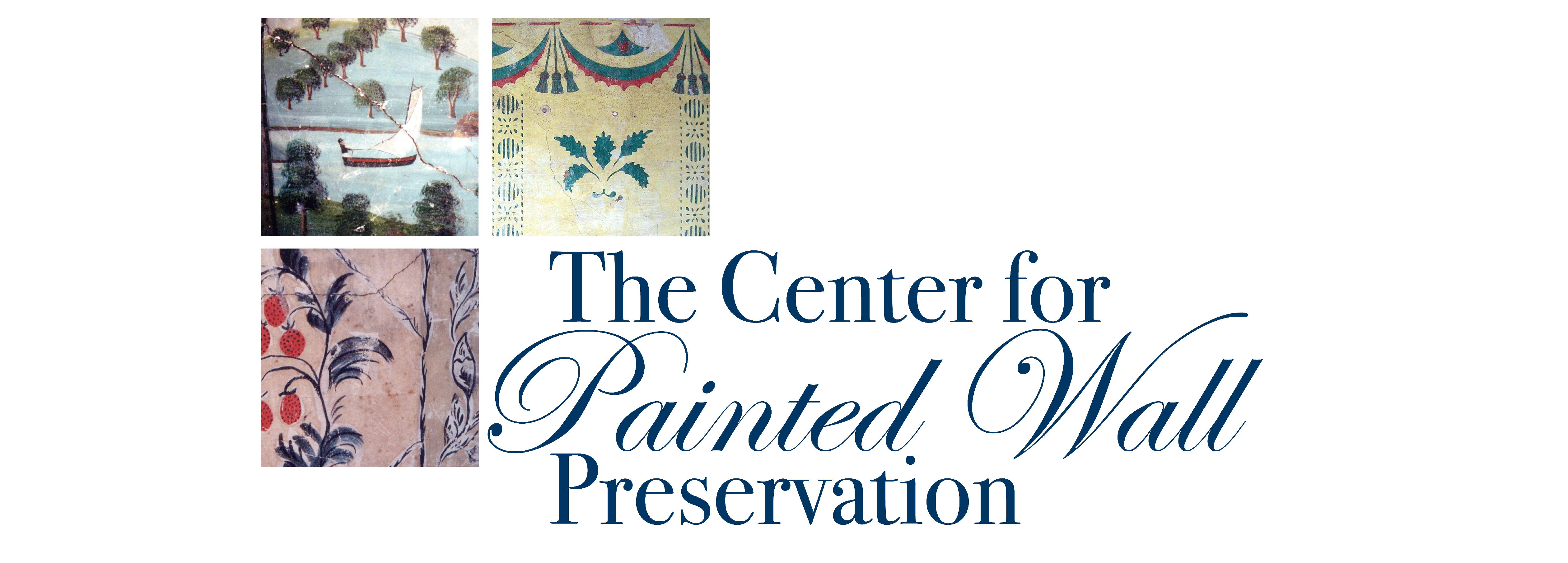
paint conservation
Paint Conservation
Decorated plaster walls are a vulnerable part of completed structures. The painted decoration often extends to woodwork, walls and adjacent rooms. The walls were a palette placed in a static position that was affected by light, location and the environment in the structure.
This example shows the wall from the Jaffrey Tavern in New Hampshire, which now hangs in the MFA in Boston, remounted and exhibited as a fragment. From the picture in 1950 one can see the graining on the fireplace surround and on the frame with the overmantel, the whereabouts of both are no longer known. The overmantel picturing the White House is now in the collection of the White House historical archives. The other three walls in the Tavern room are also in private collections.

Hiring a Professional Conservator
What to expect when enlisting a Conservator for your painted plaster:
All treatments begin with a phone consultation, site examination and report with photography, floor plans and testing to determine material composition and condition, to decide treatment path; further research & consultations with colleagues; a budget for scientific samples and funding for tax exempt projects may be necessary.
Conservation is problem solving unique to each treatment. Documentation is required and includes the following reports: Examination, Treatment proposals, Treatment record supported by photography overall and in detail of treatment phases.
A listing of conservation treatments and what is included, for example:
a. removal of wallpaper - description and method and possible results
b. consolidation of plaster and pigment layers- description of method including that it is reversible
c. retoning of these areas with reversible pigments
The estimated cost of the conservation materials
Total cost estimate for conservation treatment
What to ask a conservator when enlisting their services:
First identify what your final goal is for the painted plaster. Be clear if you want the walls to be conserved to reflect the original intent of the artist.
Clarify that any treatment that they use is reversible.
Ask to see references of other jobs that have been completed by them in the same conservation framework- ie: painted plaster.
The fragile surfaces and condition issues associated with painted wall decoration result in a frequent need to consult with an experienced conservation or preservation professional to make sure that the painting is stabilized and maintained in exhibitable condition. While many people are highly skilled at touching up flaking paint, it is imperative that the best practices are utilized for the conservation of the mural so that the restoration is easily removable as needed and does not ultimately cause more harm than good.
The ideal candidates for such a job would be a masters' program-trained historic preservation specialist or art conservator. They would have a professional affiliation with the Association for Preservation Technology International, the American Institute for Conservation (ideally in the Architecture Specialty Group) or the American Institute of Architects Historic Resources Committee. A masters' trained art conservator with a specialization in painted surfaces or finishes would also be a good candidate for the job.
One way to find a program-trained professional in your area is to contact APTI, AIC, or the AIA directly:
http:ww.apti.org/
http:www.conservation-us.org/specialty-groups/architecture#.Vk3f9cuY
http://network.aia.org/historicresourcescommittee/home
Restoration
The early paints used are primarily water/glue-based “distemper” paints. These are unfortunately extremely fragile and can be subject to dissolving when in contact with high relative humidity or water (condensation). Techniques for removing wallpaper covering these paints or a covering layer of plaster are best left to professional restorers so the original paint can be preserved intact.
We suggest owners identify their desired outcome, learn what is involved in conservation of painted plaster, and study other restored murals so the end result is pleasing to them. Much damage has occurred in the past from inappropriate irreversible techniques and heavy over-painting. Any new paint application diminishes the value of the wall murals.
Wallpaper Removal
At best, removing wallpaper from early paint-decorated walls is tedious and painstaking and best left to a professional conservator. If the paper is pulled from the wall it takes paint and evidence from the wall. Often an exact reverse imprint of the painted motifs is seen on the back side of the wallpaper – color and all. In rare cases there will be no paint loss on the back of the wallpaper. This variance is most probably due to type of glue used, age and type of paper and condition of wall when paper was applied.
A conservator will carefully design a method to release the paper from the paint, a square inch at a time, which leaves the paint intact on the wall. Each situation requires an individual approach.
This shows a mural wall in the Quincy Sylvester House in Townsend, MA, after wallpaper had been removed by homeowner. Paint losses can be observed throughout the image which might have been avoided with professional care.

Wall Care Guidelines
Many homeowners who discover painted walls in their homes become enchanted by the charming decoration. As they learn more about the historical significance of their walls, these homeowners recognize themselves as stewards of a piece of our national heritage. Following some simple suggestions can help ensure the stability and survival of walls in your home.

